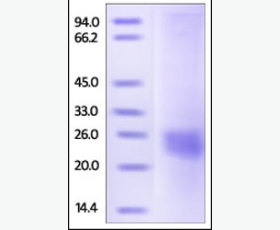Recombinant Human Uracil Phosphoribosyltransferase Homolog/UPRT
| Product name: | Recombinant Human Uracil Phosphoribosyltransferase Homolog/UPRT |
| Source: | E. coli |
| Purity: | Greater than 95% as determined by reducing SDS-PAGE. |
| Buffer Formulation: | Supplied as a 0.2 μm filtered solution of 20mM TrisHCl,150mM NaCl pH 8.0. |
| Applications: | Applications:SDS-PAGE; WB; ELISA; IP. |
| Storage: | Avoid repeated freeze/thaw cycles. Store at 2-8 oC for one month. Aliquot and store at -80 oC for 12 months. |
| UOM: | 100ug/50ug/200ug/1mg/1g |
| Source | E. coli |
| Description | Recombinant Human UPRT is produced by our E.coli expression system and the target gene encoding Met1-Asp309 is expressed with a 6His tag at the N-terminus. |
| Names | Uracil phosphoribosyltransferase homolog, UPP, FUR1, UPRT |
| Accession # | Q96BW1 |
| Formulation | Supplied as a 0.2 μm filtered solution of 20mM TrisHCl,150mM NaCl pH 8.0. |
| Shipping |
The product is shipped on dry ice/ice packs. |
| Storage |
Store at < -20°C, stable for 6 months after receipt. Please minimize freeze-thaw cycles. |
| Purity |
Greater than 95% as determined by reducing SDS-PAGE. |
| Endotoxin | Less than 0.1 ng/µg (1 IEU/µg) as determined by LAL test. |
| Amino Acid Sequence |
MGSSHHHHHHSSGLVPRGSHMATELQCPDSMPCHNQQVNSASTPSPEQLRPGDLILDHAGGNRAS RAKVILLTGYAHSSLPAELDSGACGGSSLNSEGNSGSGDSSSYDAPAGNSFLEDCELSRQIGAQL KLLPMNDQIRELQTIIRDKTASRGDFMFSADRLIRLVVEEGLNQLPYKECMVTTPTGYKYEGVKF EKGNCGVSIMRSGEAMEQGLRDCCRSIRIGKILIQSDEETQRAKVYYAKFPPDIYRRKVLLMYPI LSTGNTVIEAVKVLIEHGVQPSVIILLSLFSTPHGAKSIIQEFPEITILTTEVHPVAPTHFGQKY FGTD
|
| Background | UPRT is a cytoplasmic enzyme which belongs to the UPRTase family. UPRT is highly expressed in leukocytes, liver, spleen and thymus, with lower expression in brain, lung and skeletal muscle. UPRTcatalyzes the conversion of uracil and 5-phosphoribosyl-1-R-diphosphate to uridine monophosphate (UMP). This reaction is an important part of nucleotide metabolism, specifically the pyrimidine salvage pathway. UPRT is a potential target for rational design of drugs to treat parasitic infections and cancer |














